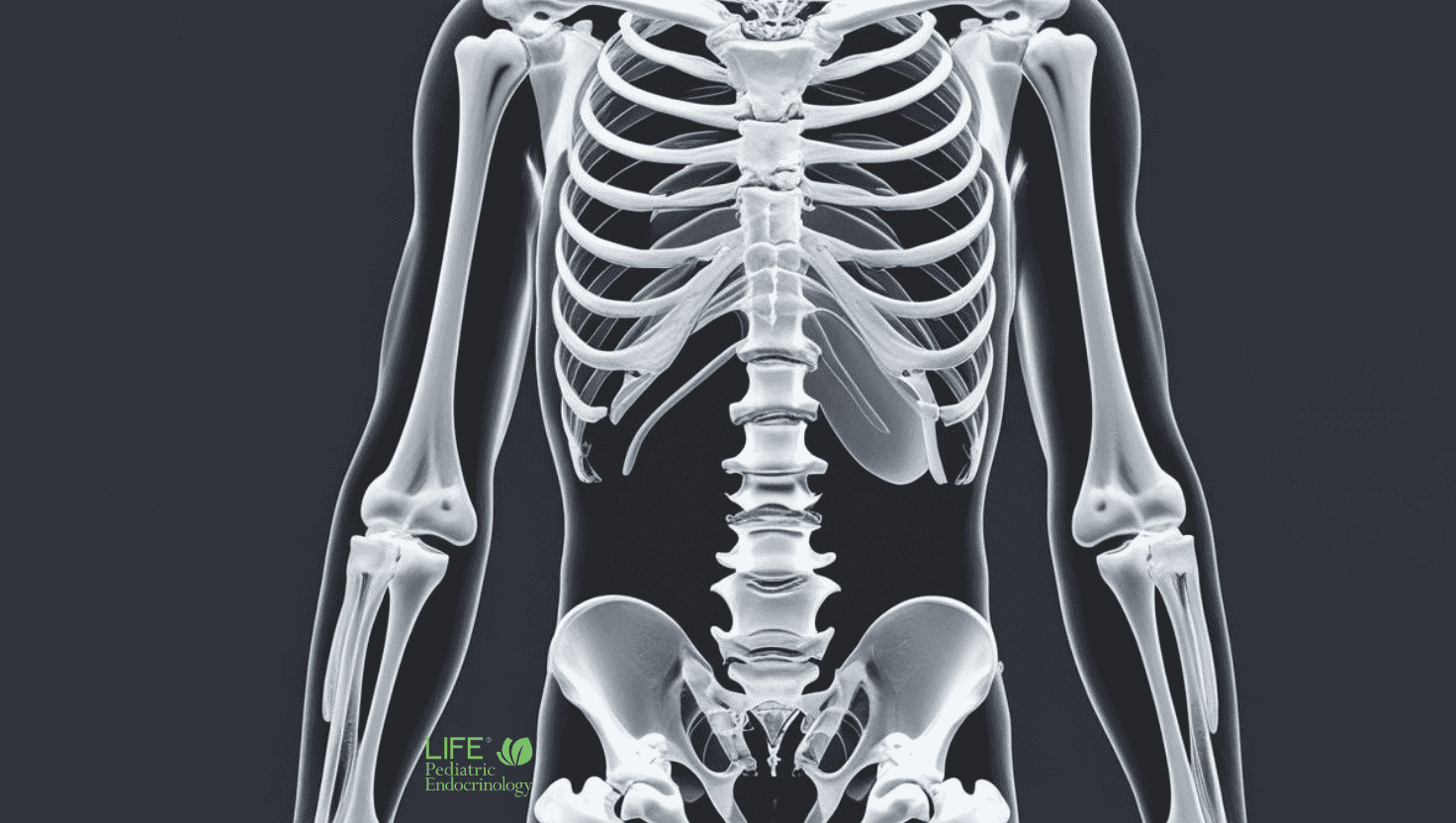Hypophosphatasia (HPP): Diagnosis and Treatment with Asfotase Alfa
When “growing pains” aren’t normal: uncovering the hidden cause behind bone pain and early tooth loss — and how enzyme therapy is changing lives.
Medically reviewed by:
Dr. Kelli Davis, MD – Pediatric Endocrinologist & Bone Health Specialist, Life Pediatric Endocrinology
Understanding HPP
Hypophosphatasia (HPP) is a rare inherited disorder caused by reduced activity of tissue non-specific alkaline phosphatase (TNSALP), leading to defective bone and tooth mineralization (Dahir & Dunbar, 2025). The deficiency causes accumulation of inorganic pyrophosphate (PPi), a natural inhibitor of bone mineralization, and pyridoxal-5′-phosphate (PLP), the active form of vitamin B6.
Low ALP results in poor bone formation (osteomalacia), early tooth loss, muscle weakness, and neurologic effects due to impaired vitamin B6 transport across the blood–brain barrier (Dahir & Dunbar, 2025).
Pathophysiology: How Alkaline Phosphatase Shapes Bone Health
TNSALP breaks down PPi, freeing phosphate to bind calcium and create hydroxyapatite, the mineral backbone of bone.
When TNSALP is absent or inactive, PPi remains high, and calcium stays outside the bone matrix—resulting in rickets in children and osteomalacia in adults (Dr. Davis, 2025).
The enzyme also plays a role in converting PLP to pyridoxal, allowing it to cross into the brain. This connection explains the neurological findings occasionally seen in severe infantile forms.
Clinical Phenotypes and Signs
HPP shows six major phenotypes based on age of onset and severity (Dahir & Dunbar, 2025):
-
Perinatal severe: often lethal due to profound hypomineralization.
-
Perinatal benign and infantile: rickets, poor feeding, and respiratory failure.
-
Childhood: delayed walking, premature tooth loss with intact roots, bone pain, and rickets.
-
Adult: fractures, pseudo-fractures, chronic pain, and fatigue.
-
Odontohypophosphatasia: isolated dental findings.
Clinical pearl: A child who says their bones hurt—not their muscles—is a red flag for HPP (Dr. Davis, 2025).
Diagnostic Workup
-
Low alkaline phosphatase (ALP): always check age-adjusted reference ranges.
-
Persistent double-digit ALP in a child is suspicious (Dr. Davis, 2025).
-
-
Serum markers: phosphate, calcium, PLP, and vitamin D.
-
Urine tests: calcium/creatinine ratio and phosphoethanolamine (PEA).
-
Imaging: X-rays for rickets or osteomalacia; renal ultrasound for nephrocalcinosis.
-
Genetic testing: ALPL mutation confirmation (Dahir & Dunbar, 2025).
Treatment: Asfotase Alfa (Strensiq®)
Asfotase alfa is the only FDA-approved enzyme replacement therapy (ERT) for HPP. It restores alkaline phosphatase activity, lowering PPi, improving bone mineralization, and relieving pain (Dahir & Dunbar, 2025).
-
Administration: subcutaneous injection 3–6 times per week, depending on age and severity.
-
Mechanism: replaces the missing TNSALP enzyme, enabling hydroxyapatite formation and PLP transport into the brain.
-
Clinical results: trials and registry data show improved growth, physical function, and survival in pediatric-onset cases (Dahir & Dunbar, 2025).
-
Long-term efficacy: maintained for years with ongoing therapy.
Monitoring and Follow-Up
Dr. Davis emphasized that accurate growth and head measurements are critical, especially for infants at risk for craniosynostosis, which must be treated before 3 months for best outcomes (Dr. Davis, 2025).
Monitoring protocol includes:
-
CMP and bone profile every 3–6 months.
-
Urinalysis for hematuria if abdominal or back pain occurs (possible hypercalcemia).
-
Renal ultrasound for nephrocalcinosis.
-
Dental evaluations and radiographs.
-
Regular symptom tracking for bone pain and fatigue.
Families should measure height and weight consistently; inaccuracies can obscure growth trends essential to care planning.
Medication Tolerance and Side Effects
Asfotase alfa is generally well tolerated.
The most common issues are injection-site reactions and dermatologic changes—seen in up to 40 % of patients. Rotating sites and using proper technique helps prevent lipoatrophy (Dr. Davis, 2025).
Other considerations:
-
Immunogenicity: antibody formation is frequent but rarely affects efficacy.
-
Adherence: stopping and restarting therapy reduces effectiveness (Dahir & Dunbar, 2025).
-
Cost: therapy can exceed $1.8 million per year for an 80 kg patient, but most insurance plans cover it when well-documented as pediatric-onset (Dr. Davis, 2025).
Insurance & Documentation
Because adult-onset HPP is not FDA-approved for treatment, accurate documentation of pediatric onset is essential for coverage.
Clinicians should record features such as early tooth loss, rickets, or childhood fractures to justify lifelong therapy (Dr. Davis, 2025).
FAQs
1. What’s the difference between rickets and osteomalacia?
Rickets occurs in a growing skeleton; osteomalacia in mature bone. Both reflect poor mineralization (Dahir & Dunbar, 2025).
2. Can adults benefit from treatment?
Yes—if HPP began in childhood. Adults with pediatric-onset disease often experience improved pain and mobility (Dahir & Dunbar, 2025).
3. How fast does Strensiq work?
Radiographs can show improvement in as little as 8 months (Dr. Davis, 2025).
4. Why do some kids lose teeth early?
Lack of alkaline phosphatase weakens the cementum anchoring teeth, so the entire root comes out (Dr. Davis, 2025).
5. What’s next in HPP research?
New agents like efzimfotase alfa are under study for broader use (Dahir & Dunbar, 2025).
About the Author
Dr. Kelli Davis, MD
Pediatric Endocrinologist & Bone Health Specialist
Dr. Kelli Davis is a board-certified pediatric endocrinologist with advanced training from Vanderbilt University Medical Center, where she specialized in bone disease, thyroid disorders, and mineral metabolism. As part of the physician team at Life Pediatric Endocrinology, Dr. Davis leads the clinic’s bone health and metabolic programs, caring for children with hypophosphatasia (HPP), brittle bone disorders, and complex growth or calcium abnormalities.
Known for her deep compassion and precision in diagnosis, Dr. Davis blends cutting-edge research with a concierge model of care that gives families the time and clarity they deserve. Her work has helped redefine how rare bone disorders are identified and managed in both children and adults with pediatric-onset disease.
Learn how bone health expert Dr. Kelli Davis explains hypophosphatasia, its warning signs, and the newest enzyme therapies changing lives.
→ Schedule a consultation with Dr. Davis and the Life Pediatric Endocrinology team to evaluate your child’s bone health today.
The information in this article is provided for educational purposes only and is not a substitute for professional medical advice, diagnosis, or treatment. Always seek the guidance of a qualified healthcare provider with any questions you may have regarding a medical condition. Never disregard or delay seeking professional advice because of something you have read here.
References
-
Dahir KM, Dunbar NS. (2025). Medical Management of Hypophosphatasia: Review of Data on Asfotase Alfa. Current Osteoporosis Reports, 23, 14.
-
Davis K. (2025). Internal LIFE team presentation on HPP pathophysiology, clinical phenotypes, monitoring, and Strensiq therapy.
Share this
You May Also Like
These Related Stories

What Is Bone Disease? Understanding Causes, Symptoms, and Treatments

What Are The Symptoms of Bone Disease?


